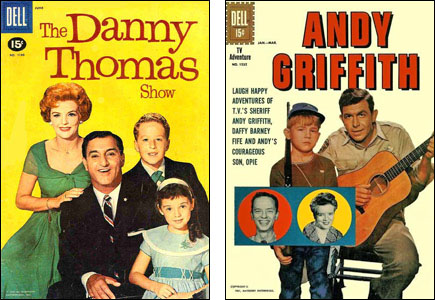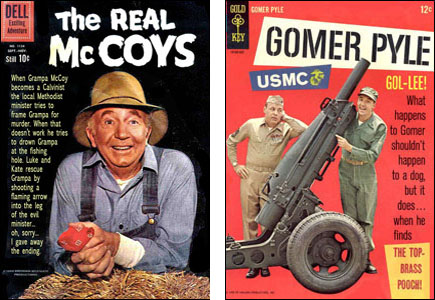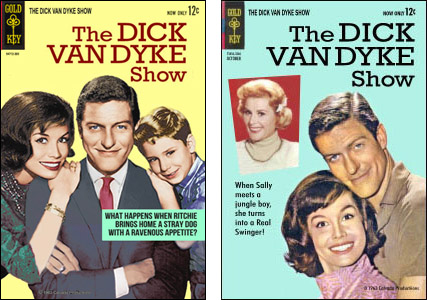
The Dick Van Dyke Show debuted on CBS on October 3, 1961. It was not an instant hit and was actually (briefly) cancelled after its first, uneven season. But soon its producers got their act together and secured a better time slot and it became one of the all-time great television comedies. America couldn't wait to tune in each week and spend time with Rob Petrie (Dick Van Dyke), his wife Laura (Mary Tyler Moore), their son Ritchie (Larry Matthews), their neighbors Millie and Jerry (Anne-Morgan Guilbert and Jerry Paris), Rob's fellow comedy writers Buddy and Sally (Morey Amsterdam and Rose Marie), long-suffering producer Mel Cooley (Richard Deacon) and egomaniacal star-boss Alan Brady (Carl Reiner). And in-between weekly episodes, one could always pick up an issue of the spurious comic book published by Western Publishing Company under its Gold Key imprint.


Western Publishing had a long history with the company that produced The Dick Van Dyke Show, a production entity run by Danny Thomas and Sheldon Leonard. For the Dell imprint, Western had created comic books of The Danny Thomas Show and The Real McCoys, both hits that came from the Thomas-Leonard stable, and Dell itself had put together two issues of The Andy Griffith Show, another Thomas-Leonard success. Under its Gold Key logo, Western would later publish the comic book of another hit Thomas-Leonard show, Gomer Pyle, U.S.M.C. The comic book based on The Dick Van Dyke Show was the biggest success of the five, lasting longer than the other four put together.
The first issue of Gold Key's version of The Dick Van Dyke Show went on sale in March of 1963 and eleven more followed for a total of twelve. Today, though the shows are constantly rerun, the comic book is largely forgotten and there are those who claim it never existed. It is not mentioned in any history, either of the TV show or comic books. So here, as a public service, is a rundown of its dozen memorable issues which feature the "lost" adventures of Rob Petrie and his friends…

The first issue of Gold Key's Dick Van Dyke Show comic book got the series off to a good start with two fine stories. "Chow Hound" begins when young Ritchie finds a stray dog on his way home from school, brings it home and asks his parents if he can keep it. Rob thinks this is a good opportunity for Ritchie to learn responsibility so he tells his son he can keep the pooch and they'll buy food for it as long as he takes care of it. Rob and Laura expect Ritchie to slough off but to their surprise, Ritchie is very diligent about walking the dog twice a day and caring for it and especially feeding it. The dog whines when it's hungry and it seems to always be hungry. Ritchie is feeding it eight or nine times a day and the dog always seems to want more.
Rob is spending a fortune for dog food but rather than break his promise to Ritchie, he goes to Mel Cooley and asks for a raise. Rob's explanation about a "new mouth to feed" confuses Mel, who thinks Rob and Laura are expecting another baby. Sally hurriedly arranges a surprise baby shower for Laura and…well, it gets pretty wacky before everything gets straightened out. Then a man shows up at the Petrie door saying that he's heard that they have his lost dogs. Rob says, "Dogs? No, we just have the one dog here." But it turns out, Rob is wrong. The reason the dog has been eating so much is that it isn't one dog. Ritchie has been feeding eight identical dogs and keeping them in the garage.
Even better was the second story in this issue, "The Comedy Computer." A network executive comes in one day and announces that they'll be laying off Rob, Sally and Buddy, and replacing them with a machine. He brings in a scientist who unveils for Mel Cooley, a computer called L.A.U.G.H., which stands for "Licensed Automation Using Gathered Hilarity." Every joke in the world, he explains, is programmed into the computer so you just have to type in a subject and it selects the proper jokes and even assembles them into a script. Rob protests that no computer can create a good comedy script and he has a secret weapon that can prove that: Buddy. A contest is set up with the L.A.U.G.H. computer competing against Buddy Sorrell, the Human Joke Machine. Buddy and the computer challenge each other in a big amphitheater with all the movers and shakers of the comedy business looking on. The computer selects a subject and they each have to come up with jokes about it. Then Buddy selects a subject and they each have to come up with jokes about it. It goes back and forth, and Buddy gains ground when the topic is "Mothers-in-law" but loses when it's "Crumpled punchcards." Then he falters badly when the computer selects "Famous Bolivian Soccer Games." The computer has a huge selection of them (my favorite is the one about Alberto Ruiz) and it looks like Buddy's going down to defeat. At the last minute, in a stunning reversal, he asks, "Why did the chicken cross the road?" which turns out to be the one joke not in the L.A.U.G.H. database. The computer begins to smolder and spark and it finally blows up. Buddy wins! The computer is scrapped but we haven't seen the last of it. Sally buys it and announces that she's heard all about computer dating and is going to reprogram the thing to find her a fella!
The best thing about the issue is the artwork done by Dan Spiegle, who was then known principally for western comics such as Maverick and the Hopalong Cassidy newspaper strip. There are one or two panels where Dick Van Dyke looks more like James Garner but for the most part, Spiegle did a great job capturing not only the likenesses of the cast members but their distinct expressions and postures. When Alex Toth drew a comic book of The Danny Thomas Show for Western Publishing, Thomas was constantly complaining about the way he was drawn and ordering that his nose be made smaller. But Dick Van Dyke, who was something of a cartoonist himself, was flattered by Spiegle's drawings and even sent the artist a fan letter illustrated with a little self-portrait. The editors at Western Publishing saw the letter and invited Van Dyke to draw a cover for the comic book and he said he wanted to, but unfortunately never got around to it. Perhaps if he had, some of the problems that plagued later covers of the comic book might not have happened. There were also problems with the insides because, against his wishes, Spiegle was not allowed to continue on the comic. Still, the book was off to a good start.
The second issue was not quite as good as the first issue. It featured two stories, each twelve pages in length. In the first, "Sally of the Jungle," a Johnny Weismuller-type actor guest-stars on The Alan Brady Show and he and Sally hit it off. When he has to go back to Africa to film his next Jungle Man movie, Sally agrees to quit her job and go off with him. (He promises they'll be married by "an authentic tribal chieftain and witch doctor.") Unfortunately, when Sally gets a look at how the guy eats (all raw plants and insects) and how they'll have to live — to say nothing of her prospective mother-in-law, who she refers to as "Cheetah" — it's back to New York, the single life and the TV business for her.
This was the only appearance in the comic of Sally's occasional boy friend from the TV show, Herman Glimsher but the artist obviously didn't have any reference on Bill Idelson, the actor who played the role. Herman looks more like Buddy Hackett.
In the second story in the issue, "Rob's Bad Luck Day," Rob Petrie accidentally bumps a little old gypsy woman at the supermarket and she angrily puts what she calls a "bad luck curse" on him. Rob doesn't believe in curses but as one thing after another goes wrong, he starts believing. After he accidentally spills an entire vat of fruit punch on Mel Cooley, Rob panics. He and Buddy go racing around town, looking for the old gypsy woman so he can beg her to remove the curse. It's kind of a silly plot and the ending (except for the part about the blintzes) is rather predictable. I don't know who did the scripts or art on this issue and the latter, after the nice job by Dan Spiegle in #1, is a definite letdown. Dan doesn't know why he was taken off the book after only one issue, as he very much enjoyed the assignment. The best things about this issue are the little one-page gag where Laura installs a mechanical safety net on the ottoman for when Rob trips, and the two-page filler story of "Buddy Sorrell, the Human Joke Machine." All in all, a definite disappointment.